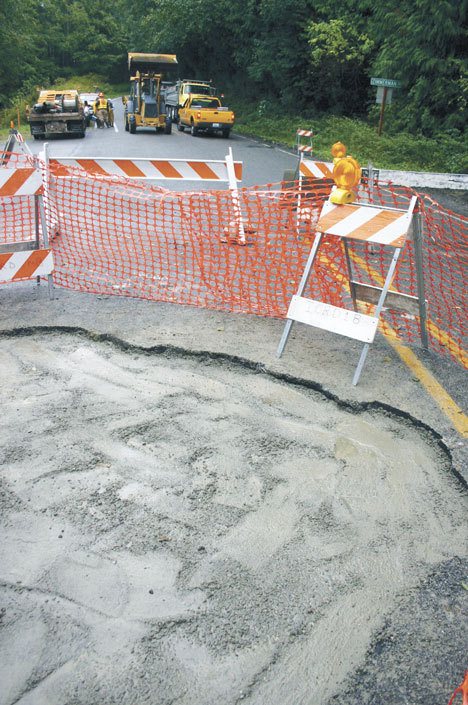Island County road crews plugged the mother of all potholes Monday on Bob Galbreath Road, but officials said it may be some time before permanent repairs can be made and the roadway reopened.
Crews worked through the weekend to fill a 10-foot-wide sinkhole that swallowed the northbound lane of Bob Galbreath Road near Zimmerman Road.
The gap was reported early Friday morning, and was caused by the failure of an old 2-foot-wide culvert about 20 feet below the road.
“It’s big, as a hole goes, but it’s not huge,” said Randy Brackett, assistant county engineer. “It would have swallowed a truck, but not a bus.”
Brackett said the first driver to pass over the roadway as it was crumbling was on the way to the gym, and thought the growing hole was a pothole and kept going.
“On the return trip, when the hole had widened out and they learned what they had driven over, they were astounded,” Brackett said.
The next driver had an even closer escape. The wheels of the vehicle passed just outside the edges of the growing hole.
The driver came back to look, then set up an impromptu barricade in front of the gap constructed of a cardboard box set on top of a plastic bag of wood chips. The driver then called 911.
When county crews arrived, the hole was four feet wide. The road was immediately closed; an automated traffic warning sign now sits not far from the Highway 525 intersection to warn travelers of the closure.
Brackett declined to guess when the road would reopen.
“We’re prepared to have the road closed for a week,” he said.
Brackett said the void beneath the roadway — caused by water escaping from the pipe and leaching away the sandy layers of earth surrounding the line — could have been growing for weeks, months or years.
Eventually, the hole grew large enough to spread from the road’s edge on the northbound lane to the double yellow line in the middle of Bob Galbreath Road.
Public works crews tackled the problem through the weekend. They returned on Monday, filling Mother Nature’s crater with quarry spalls, smaller stone and finally, a cement-style slurry for the last two feet on top. The hole was big enough at the surface that it took about nine yards of the cement mixture to fill. Several more inches of material will be needed to smooth out the roadway, likely cold-patch asphalt.
The county declared an emergency to give the public works department the green light to pay for a quick fix. The total cost of the repair job was not immediately known.
Brackett praised the work of county crews and South Ender Todd Graves, who was able to string a 200-foot-long sleeve of a plastic-type pipe through the failed line so water could continue to be routed underneath the roadway.
“This is only an emergency repair,” Brackett added. “We still have to look at what a long-lasting repair will take, both in money and in time, and the timing to do that work.”
Talks have started about a permanent solution, but Brackett warned that the line can’t be touched while it’s still needed to handle flows beneath the busy roadway.
“We’re painfully aware that we are just at the beginning of the storm season,” he said. “Water is going to have to flow through that pipe.”
Brackett said the depth of the pipe also “presents its own challenges to repair and or replace.”
Even so, there was an upside, he said.
“No one fell in,” Brackett joked.



